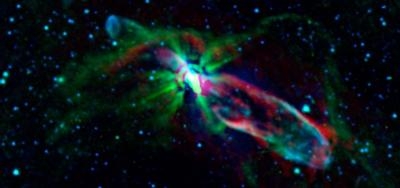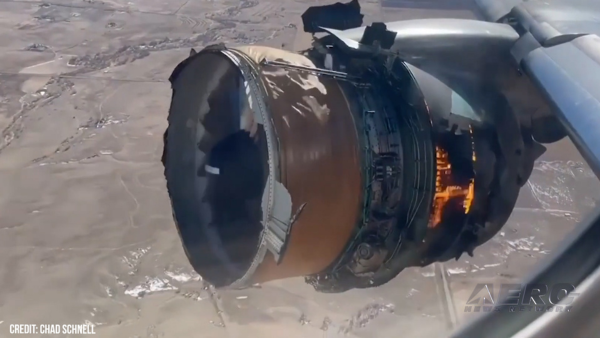Thu, Nov 14, 2013
Spacecraft And Terrestrial Facility Present Most Complete Picture Of Stellar Formation To Date
It's a bouncing baby . . . star! Combined observations from NASA's Spitzer Space Telescope and the newly completed Atacama Large Millimeter/submillimeter Array (ALMA) in Chile have revealed the throes of stellar birth as never before in the well-studied object known as HH 46/47.

Herbig-Haro (HH) objects form when jets shot out by newborn stars collide with surrounding material, producing small, bright, nebulous regions. To our eyes, the dynamics within many HH objects are obscured by enveloping gas and dust. But the infrared and submillimeter wavelengths of light seen by Spitzer and ALMA, respectively, pierce the dark cosmic cloud around HH 46/47 to let us in on the action.
The Spitzer observations show twin supersonic jets emanating from the central star that blast away surrounding gas and set it alight into two bubbly lobes. HH 46/47 happens to sit on the edge of its enveloping cloud in such a way that the jets pass through two differing cosmic environments. The rightward jet, heading into the cloud, is plowing through a "wall" of material, while the leftward jet's path out of the cloud is relatively unobstructed, passing through less material. This orientation serves scientists well by offering a handy compare-and-contrast setup for how the outflows from a developing star interact with their surroundings.
"Young stars like our sun need to remove some of the gas collapsing in on them to become stable, and HH 46/47 is an excellent laboratory for studying this outflow process," said Alberto Noriega-Crespo, a scientist at the Infrared Processing and Analysis Center at the California Institute of Technology, Pasadena, CA. "Thanks to Spitzer, the HH 46/47 outflow is considered one of the best examples of a jet being present with an expanding bubble-like structure."
Noriega-Crespo led the team that began studying HH 46/47 with Spitzer nearly 10 years ago when the telescope first began observing the heavens. Now, using a new image processing technique developed in the past few years, he and his colleagues have been able to render HH 46/47 in higher resolution.
Meanwhile, the fresh views of HH 46/47 by ALMA have revealed that the gas in the lobes is expanding faster than previously thought. This faster expansion has an influence on the overall amount of turbulence in the gaseous cloud that originally spawned the star. In turn, the extra turbulence could have an impact on whether and how other stars might form in this gaseous, dusty, and thus fertile, ground for star-making.
A team led by Hector Arce at Yale University, New Haven, CT, carried out the ALMA observations and their analysis was published recently in The Astrophysical Journal.
(Image provided by NASA)
More News
Also: New SAF, Korean Air Buys 103 Boeings, Maryland SP Helo Rescue, OK AWOS Update Gulfstream Aerospace Corporation announced its first customer delivery of the all-new Gulfstream>[...]
"This is just an absolute win win win. If there is a rejected takeoff we now have the confidence that the arrestor system will ensure passenger and crew safety." Source: FAA Admini>[...]
Low Approach An approach over an airport or runway following an instrument approach or a VFR approach including the go-around maneuver where the pilot intentionally does not make c>[...]
Aero Linx: Historic Aircraft Association (HAA) The Historic Aircraft Association (HAA) was founded in 1979 with the aim of furthering the safe flying of historic aircraft in the UK>[...]
While Flying About 1,500 Ft Above Ground Level, A Large Bird Struck The Right Side Of The Airplane Analysis: The pilot reported that while flying about 1,500 ft above ground level,>[...]
 Airborne 08.29.25: G800 Delivery, Alaska F-35 Crash, USCG-RCAF Medevac
Airborne 08.29.25: G800 Delivery, Alaska F-35 Crash, USCG-RCAF Medevac Aero-News: Quote of the Day (08.30.25)
Aero-News: Quote of the Day (08.30.25) ANN's Daily Aero-Term (08.30.25): Low Approach
ANN's Daily Aero-Term (08.30.25): Low Approach ANN's Daily Aero-Linx (08.30.25)
ANN's Daily Aero-Linx (08.30.25) NTSB Final Report: Excalibur Excalibur
NTSB Final Report: Excalibur Excalibur



